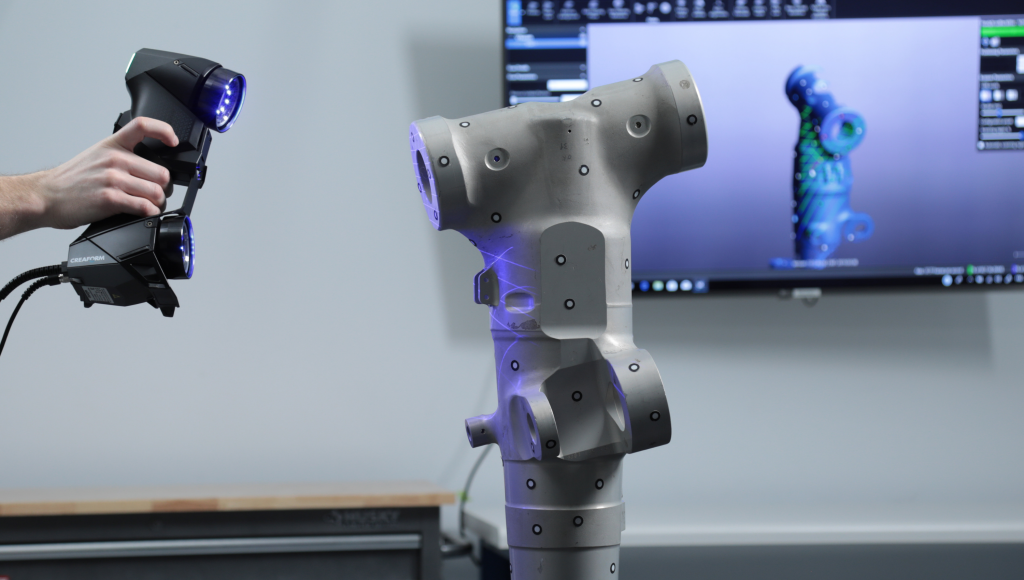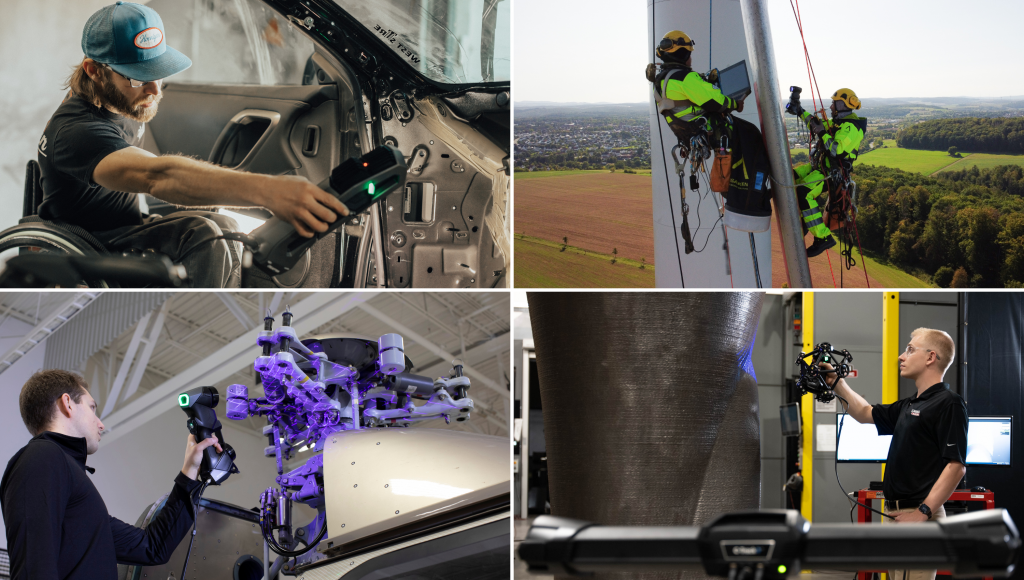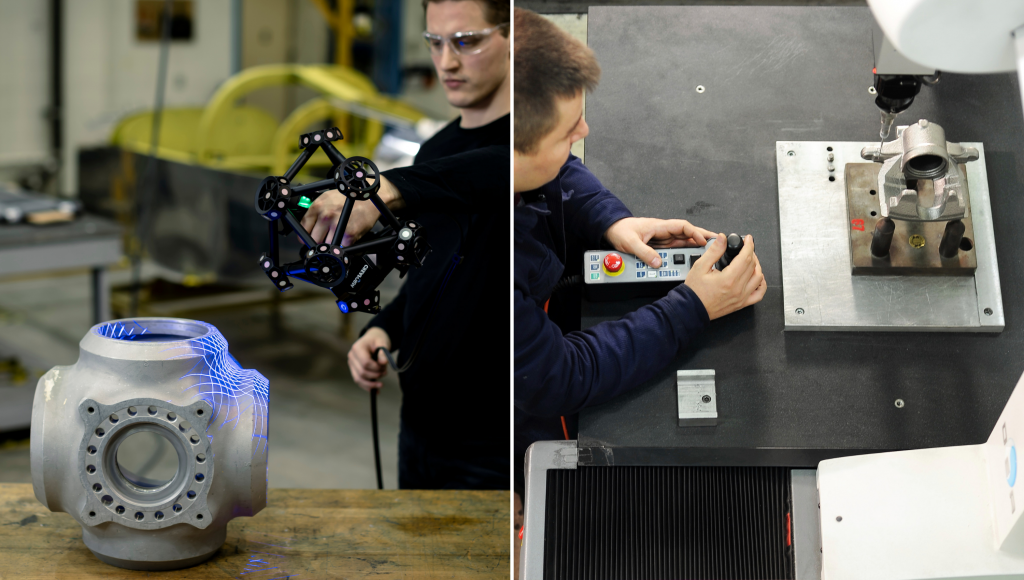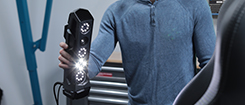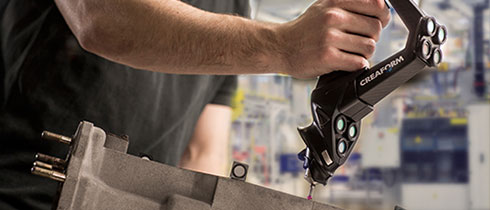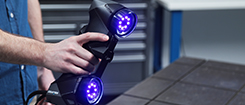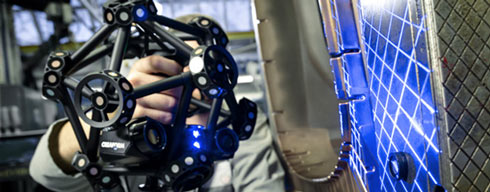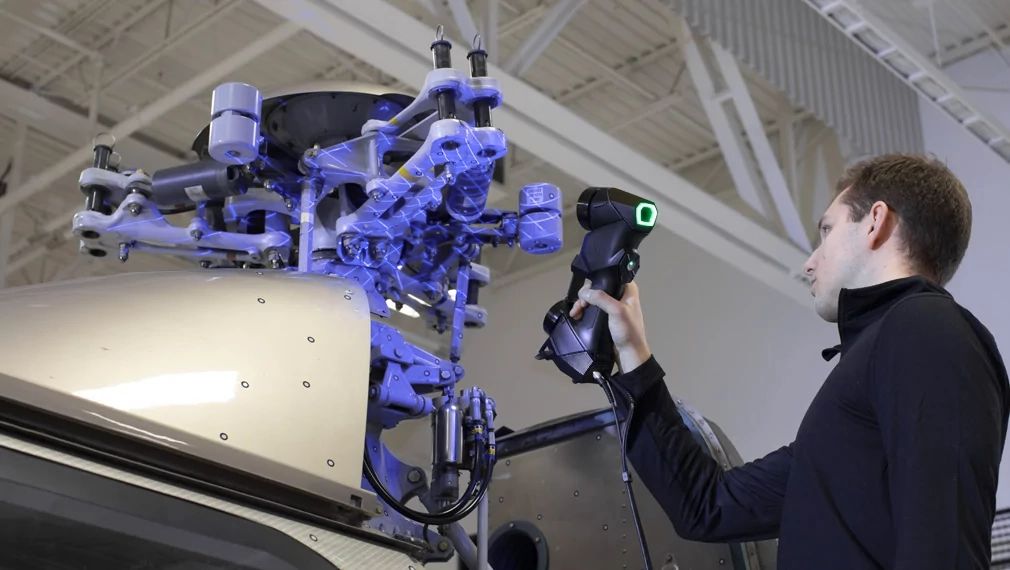July 24, 2024
Improving Vessel Integrity at a Refinery thanks to Advanced 3D Scanning Technology See the article3D laser scanners are a hot topic these days. 3D laser scanning is an advanced technology with a market growth forecasted by some reports to grow at a CAGR of 7.5% from 2021 to 2026. Other research indicates that the 3D laser scanner market will likely reach $16.66 billion by 2030.
But what is a 3D laser scanner? What are 3D laser scanners used for? How can a company choose the best 3D laser scanner on the market? This article will give you all the details you need on 3D laser scanning.
- 1 What is a 3D laser scanner?
- 2 What industries use 3D laser scanners?
- 3 What is a 3D laser scanner used for?
- 4 What is the difference between laser scanning and fixed CMM scanning?
- 5 How much does a 3D laser scanner cost?
- 6 How to choose the best 3D laser scanner on the market
- 7 What is the future of 3D scanning?
- 8 Additional 3D laser scanner resources
What is a 3D laser scanner?
A 3D laser scanner is a non-contact and non-destructive device that digitally captures 3D measurements of objects and their surrounding environments using lasers. As a user scans an object, the 3D laser scanner projects a coded pattern of light from the lasers. This coded pattern will match the shape of the object to create a digital version of it.
The digital copy of the object can then be exported as a polygon mesh file, which is a representation of the 3D model, and used in different computer-aided design (CAD), inspection or 3D printing software.
What can a 3D laser scanner do?
Depending on its brand, make and model, a 3D laser scanner can be used to scan all sorts of objects, regardless of the complexity of their geometries, shapes, size, materials and surface finishes. In fact, specialized 3D laser scanners can even scan very large objects as well as human bodies and buildings!
Portable and handheld 3D laser scanners also enable operators to use them just about anywhere to acquire accurate 3D measurements no matter what the surrounding environment is like. Whether users need to scan a part right on the production floor, a pipeline that has been excavated, or a hard-to-reach and ultra-small component in a vehicle, 3D laser scanners can generate the data required for further processing.
What industries use 3D laser scanners?
You may be asking where are 3D laser scanners used? The simple answer is…virtually anywhere! At their basic concept, 3D laser scanners contribute to creating 3D models (or replicas) of physical objects. That means professionals in many different sectors use 3D laser scanners, such as:
- Aerospace
- Transportation and automotive
- Consumer products
- B2B manufacturing
- Education
- Heavy industries
- Healthcare
- Heritage, art and architecture
- Oil and gas
- Power generation
- And so much more!
In addition, thanks to the democratization of 3D laser scanning technologies, affordable and professional-grade 3D laser scanners are proving to be a boon for hobbyists, artists, tinkerers and everything in between. Check out some of the amazing projects that are carried out with more accessible 3D laser scanning solutions.
What is a 3D laser scanner used for?
Now that you know what industries typically use 3D laser scanners, let’s explore the wide range of 3D laser scanning applications, including manufacturing. But remember: 3D laser scanners are not just for production.
Here are some examples:
| Application | Example |
| Product development and design | Metrology-grade 3D scanners are designed for product development. They can help engineers and industrial designers develop innovative new products, like high-performance street and offroad sport motorcycles. |
| 3D printing (additive manufacturing) | Design teams can quickly create prototypes of parts or complete products using 3D laser scanners and a 3D printer. |
| Reverse engineering | Production teams use 3D laser scanners to reverse engineer critical parts for which they don’t have the original 3D models, such as in the automotive industry’s aftermarket. |
| Quality control and quality assurance | Inspection teams leverage high-end 3D laser scanners to improve the quality control in additive manufacturing processes for large parts. Many QC teams opt for portable optical CMMs and other 3D scanners for quality control and quality assurance. |
| Maintenance, repair and overhaul (MRO) | MRO professionals take advantage of 3D laser scanners to assess critical damage to aircraft components. |
| Non-destructive testing (NDT) | Carrying out inspections in nuclear power plants is facilitated by 3D laser scanners. |
| Science and education | Researchers and professors are teaching the engineers and industrial designers of tomorrow how to use 3D laser scanners in their field of work. |
| Medical and healthcare | Medical professionals and technicians use 3D laser scanners to create custom-moulded cranial remolding orthoses. |
| Heritage, archaeology, architecture and art | Heritage and art preservation/archiving is simplified when restorers use 3D laser scanners. |
| Multimedia, visual effects and the metaverse | 3D laser scanners are used to create non-fungible token (NFTs) for digital art and 3D models in the metaverse. |
| Building and construction | The construction industry is increasing opting for 3D laser scanners for everything from validating design execution to creating building 3D models. |
What is the difference between laser scanning and fixed CMM scanning?
While there is a variety of 3D measurement solutions available on the market, two solutions are often compared: portable 3D laser scanners and fixed coordinate measurement machines (CMMs).
Both technologies feature the accuracy levels required for professional use. A CMM is made up of a solid granite base table, gantry or bridge-mounted arm and a touch probe to be used for tactile measuring. It is often located in a laboratory or dedicated room because it can be very sensitive to ambient conditions, such as vibrations, dust, humidity levels, etc. The main advantage is that a CMM is highly accurate; however, it needs to be operated by an experienced metrologist, it can be slow, and is limited in flexibility. Parts need to be carried to the CMM, which makes it inefficient for accelerated throughput and difficult to use for large parts.
Portable 3D laser scanners are, in general also very accurate. Depending on the brand and model, they are fast at acquiring 3D measurements. What’s more, thanks to their intuitive interfaces and ergonomic designs, they are easy to use by operators of all skill levels. Also, because they are portable and robust, 3D laser scanners can be used right on a shop floor or outside; they can withstand harsh conditions without sacrificing data accuracy, reliability and repeatability.
Oftentimes, manufacturers, for example, will invest in both technologies. They will use the CMM for only the most important inspections that require the highest level of accuracy. 3D laser scanners are used for all other 3D measurements, eliminating bottlenecks at the CMM and improving overall productivity.
There are a variety of 3D scanners businesses can choose from to make the transition from their legacy CMM. These include portable 3D scanners and optical CMM 3D scanners.
How much does a 3D laser scanner cost?
The price range of 3D laser scanners depends on the quality and performance levels of the devices.
Cheap 3D laser scanners can be found for less than $1000. Medium-price 3D laser scanners can hover in the tens of thousands. Metrology-grade 3D laser scanners, especially those used for automated quality control, Industry 4.0 processes, and critical product design applications with extremely tight tolerances and strict standards, can be priced at over $100K.
More often than not, companies don’t want to risk the significant operational costs and substantial business damage that can be caused by using below-par 3D laser scanners. Here are some instances of why using a low-cost 3D scanner in professional applications can be a huge mistake.
- Performing inspections on aircraft components with a 3D laser scanner without the right accuracy levels could prove fatal for passengers in the event of a crash.
- During NDT assessments on oil and gas pipelines, inaccurate data can mean inspectors may not detect potential damage, like cracks and corrosions, that can cause catastrophic failures that put the surrounding population and environment in danger.
- Imagine if quality control teams on a manufacturer’s new vehicle miss defects in its sub-assemblies, which later on entails an extensive—and costly—car recall.
You can read this article for more information on the problems associated with low-cost 3D laser scanners for professionals here.
How to choose the best 3D laser scanner on the market
Selecting the right 3D laser scanner for your specific application depends on a myriad of factors. What should you consider when choosing a professional- and metrology-grade3D laser scanner?
Make sure you take the following criteria and functionality when purchasing a 3D laser scanning system:
- Accuracy and repeatability: How accurate do you need the 3D laser scanner to be? Does your application require high tolerance levels or compliance with stiff norms? If so, you will want to gain peace of mind knowing the 3D laser scanner you opt for generates accurate and repeatable results.
- Resolution: In terms of resolutions, the quality of the scan data output will probably be important if your application entails making assessments with a high level of detail. The higher the resolution, the more detail there is on the 3D model.
- Speed: Is team efficiency critical? Are you designing a product that must have a fast time to market? Low-cost 3D laser scanners can take much more time to capture data than professional 3D laser scanners.
- Ease of use: Some 3D laser scanner technologies are easier to use than others. Be sure to test drive how intuitive and ergonomic each 3D laser scanner is. The last thing you want is for your team to be bogged down by complicated setups and use.
- Part size: Do you normally take 3D measurements on small parts, large parts, or components of all sizes? The specs of 3D laser scanners should inform you of the range in sizes, either in mm, cm or m (in or ft). For example, if you need to scan large parts, be sure that the 3D scanner you choose has a large scanning area and can measure parts up to 15 m (49.2 ft).
- Portability: Just how portable is the 3D laser scanner you are evaluating? True portability comes from not having to use an external positioning device. A 3D laser scanner should be completely standalone so that it can be used on a shop floor, for fieldwork, or in unstable/uncontrolled/tight areas. You can read more about the importance of portability in 3D laser scanning technologies here.
- 3D laser scanning software: Not all manufacturers provide integrated 3D software platforms that work seamlessly with their 3D laser scanners. This type of software features various modules or functionalities, including facilitating the transition between the scan data to CAD software and accelerating dimensional inspections. You get the most out of your 3D laser scanner with software that takes the post-scanning process to a whole new level.
- Training, support and maintenance: Investing in a 3D laser scanner should also include carefully determining the level of localized training, comprehensive support and care plans, and maintenance/repair services the manufacturer offers. Quality and high-end 3D laser scanner manufacturers back their devices with a stellar after-sales service, either directly through them or their network of certified distributors.
- Certifications: Not all 3D scanning suppliers are created equally. While cost must be factored into the equation, so should the quality of the 3D scanner’s design and fabrication as well as its certifications, such as acceptance test based on VDI/VDE 2634 part 3 and ISO 10360, taking place in ISO/IEC 17025 accredited calibration laboratories.
What is the future of 3D scanning?
The future of 3D scanning looks very promising and is expected to see significant advancements across various fields. Here are some key trends and developments that are already hitting the market:
3D scanners with increased accessibility and affordability: As 3D measurement technologies mature, the cost of 3D scanners is expected to decrease, making them more accessible to a broader range of users. For examples, professionals in product development and design are increasingly using metrology-grade 3D scanners to reduce their time to market. These latest 3D scanners offer high accuracy and fast 3D scanning speeds at affordable prices. The payback can be generated very quickly.
Easier transitions to automated quality control with 3D scanners: Bigger, multinational companies have started to use advanced 3D scanners to automate their quality control processes. However, innovations are also permeating with standard 3D scanners so that businesses can benefit from automated quality control. Imagine being able to use your 3D scanner or optical CMM 3D scanner, along with an Automation Kit, (a cobot and digital twin software) in a turnkey solution to automate quality control and quality assurance workflows.
Better performance levels: Regardless of whether you are in product development, quality assurance, or quality control, the technical specifications of 3D scanners, including accuracy, measurement rates, volumetric accuracy, automatic volume extension accuracy, working distances, and resolutions, are becoming even more impressive.
Integrated 3D scanning software: 3D scanning software, integrated with 3D scanners, brings a company’s 3D measurement performance and efficiency to new heights. Scan-to-CAD software, dimensional inspection software, digital twin environment software, and dynamic tracking measurement software are game-changers that produce superior accuracy and data quality from 3D measurements generated by 3D scanners.
Enhanced ease of use: Metrology-grade 3D scanners are oftentimes ergonomic and highly intuitive, which means operators of all skill levels can use them—a very handy approach in today’s tight labour market. But did you know that some 3D scanners come with features and accessories, such as the Accu+ Kit, which includes scale bars that assist users to confidently rely on optimized volumetric accuracy.
Additional 3D laser scanner resources
If you’re interested in learning more about 3D laser scanners, check out some of these great resources:

|

|

